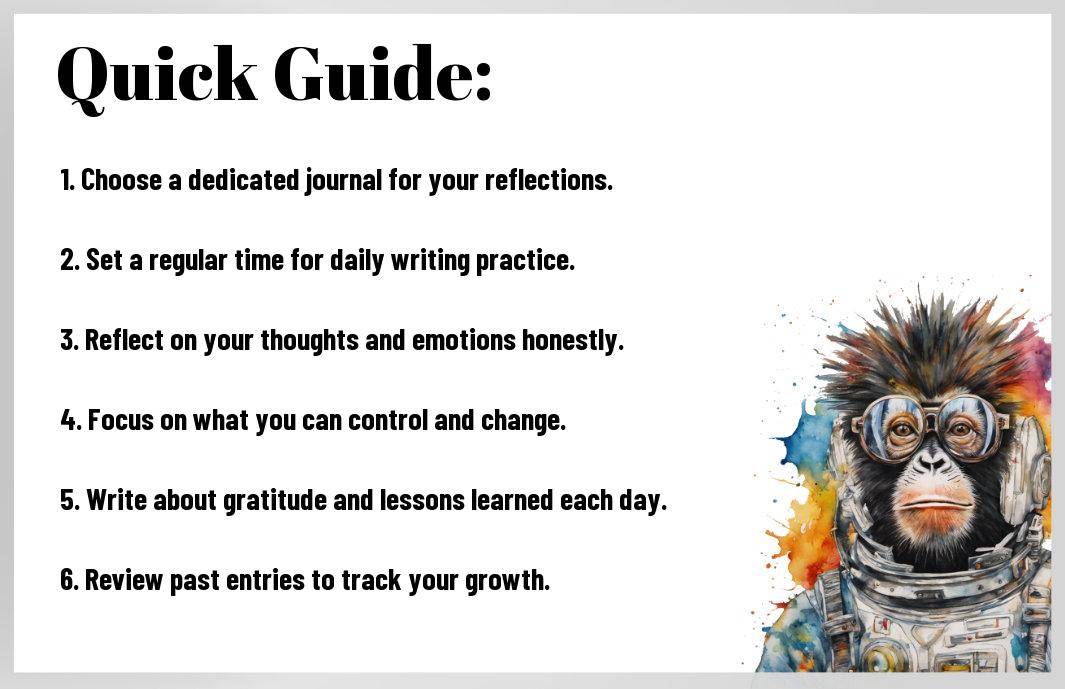This guide is here to help you embrace the timeless practice of journaling through the lens of Stoic philosophy. If you’re looking to cultivate mindfulness, enhance your self-reflection, and navigate life’s challenges with clarity, then you’ve come to the right place. I’ll walk you through the basics of Stoic journaling, share practical tips, and offer prompts that you can start using today. Let’s initiate on this journey together and unlock the transformative power of your thoughts on paper!
Key Takeaways:
- Purpose of Journaling: Journaling helps clarify thoughts, reflect on emotions, and cultivate a mindful approach to daily challenges.
- Stoic Principles: Incorporating Stoic philosophy encourages resilience and perspective, fostering an understanding of what is within your control.
- Daily Reflections: Engaging in daily reflections promotes self-awareness and gratitude, allowing you to focus on personal growth.
- Negative Visualization: Practicing negative visualization helps prepare for adversity by considering worst-case scenarios and building mental fortitude.
- Virtue and Character: Journaling about virtues aligns actions with values, reinforcing the importance of living a principled life.
- Structured Approach: Utilizing prompts can guide your journaling practice, making it easier to explore diverse aspects of your life.
- Consistency is Key: Regular journaling fosters a habit that enhances mental clarity and emotional well-being over time.

Exploring the Types of Journaling
Before stepping into the world of journaling as a Stoic, I found it helpful to explore the various types of journaling available. Each type serves a different purpose and can complement my stoic practice in unique ways. Here are some popular forms of journaling I can consider:
| Type of Journaling | Description |
| Daily Reflections | Capturing thoughts and events from the day. |
| Gratitude Journaling | Focusing on what I am thankful for. |
| Dream Journaling | Documenting and analyzing dreams. |
| Goal Tracking | Setting, monitoring, and reviewing goals. |
| Creative Writing | Exploring ideas through stories and poetry. |
Perceiving these diverse options allows me to choose the journaling approach that aligns best with my contemplative focus as a Stoic. Whether it be reflecting on my day or cultivating gratitude, journaling can be a powerful tool in my personal growth journey.
Daily Reflections
The practice of daily reflections is all about taking a moment to absorb what has happened throughout the day. I can jot down my thoughts, feelings, and experiences, allowing me to analyze my reactions to different situations. This process leads to better self-awareness and encourages me to consider how I can respond more stoically in similar circumstances in the future. Reflecting on my actions helps me to stay accountable to my values as I navigate life’s ups and downs.
The beauty of daily reflections lies not only in looking back but also in setting intentions for the upcoming days. By evaluating my behaviors and thoughts, I create a clear pathway for improvement. This not only aids in my own development but also enhances my understanding of the Stoic ideals I aspire to embody, encouraging open-mindedness and growth.
Gratitude Journaling
The act of gratitude journaling shifts my focus from what I lack to what I already have. This practice allows me to appreciate the small details in my life that often go unnoticed. By writing down things I am grateful for each day, I cultivate a positive mindset that aligns with Stoic philosophy. It helps me to recognize that joy can be found even in mundane moments and challenges, which is a critical element of developing resilience.
Incorporating gratitude journaling into my routine has transformed the way I perceive my daily experiences. Each entry serves as a reminder of the abundance present in my life, no matter how trivial the details may seem. Through journaling these grateful thoughts, I amplify my overall well-being, promote mindfulness, and nurture a more profound sense of contentment.
Journaling regularly about my gratitude helps me to keep a mental catalog of the positivity surrounding me, reassuring me during tough times. This practice reaffirms that even while facing challenges, there is always something to appreciate, which ultimately encourages a more fulfilling and balanced life.
Tips for Effective Journaling
The journey of journaling can be incredibly rewarding, but it helps to have some strategies in place to make the most of your experience. First and foremost, consistency is key. I’ve found that establishing a regular routine for journaling allows me to dive deeper into my thoughts and feelings. Additionally, reflective prompts can guide the journaling process, helping you explore various aspects of your life. Here are a few tips I recommend:
- Set a specific time each day for journaling.
- Choose a comfortable space that inspires creativity.
- Keep your journal close by for spontaneous thoughts.
- Use prompts or quotes to spark reflection.
- Be honest, no one else needs to read it!
Recognizing what works best for you can transform your journaling practice into a fulfilling ritual that enhances your understanding of yourself and the world around you.
Setting the Right Environment
One of the first steps I took in my journaling journey was creating an inviting space. I realized that my surroundings could either inspire me or distract me from the task of self-reflection. Consider finding a quiet corner of your home or a cozy spot in a park where you can sit comfortably without interruptions. I like to add personal touches, like scented candles or uplifting artwork, to make my journaling space feel special. This intentional environment fosters a sense of peace and focus, allowing my thoughts to flow freely.
It’s also important to ensure that you have all the necessary materials handy, whether it’s a beautiful notebook, a favorite pen, or even digital tools if you prefer typing. The right setup makes journaling feel like a treat rather than a chore, making it easier to express myself regularly.
Finding Your Unique Style
Effective journaling is all about discovering what resonates with me and adapting my approach as needed. It might involve writing longform reflections, jotting down bullet points, or even doodling alongside my thoughts. Over time, you’ll find techniques that suit your preferences, which can make the journaling process both enjoyable and enlightening. I encourage you to experiment with different methods, such as maintaining a gratitude log, recording daily events, or brainstorming ideas for future projects.
The beauty of journaling lies in its flexibility; what works for one person may not work for another. By exploring various styles, you’ll not only find what feels most comfortable, but you’ll also uncover deeper insights about yourself along the way. This personal touch makes your journaling practice uniquely yours, turning it into an adventure in self-discovery. Recognizing your journey and evolution in this process will ultimately enrich your experience.
A Step-by-Step Guide to Start Journaling Like a Stoic
Now, if you’re ready to examine the world of Stoic journaling, I’ve broken it down into manageable steps that can help you get started on the right foot. Each section is designed to guide you through the process with ease.
Table of Steps
| Step | Description |
| Preparing Your Mindset | Setting a clear intention for your journaling practice. |
| Choosing Your Tools | Selecting the right journal and writing implement. |
| Establishing a Routine | Creating a consistent journaling schedule. |
| Reflecting on Your Thoughts | Engaging with your entries deeply and thoughtfully. |
Preparing Your Mindset
Your journey into Stoic journaling really begins with the right mindset. I find it beneficial to take a moment to reflect on my intentions for this practice. I’m not just writing for the sake of writing; I want to deepen my understanding of myself and the world around me. Think about what you hope to gain from journaling. It could be clarity, emotional resilience, or simply a way to process daily events.
To support this, I often start with a few moments of silence, allowing my thoughts to settle before I write. It’s all about creating a calm space for my thoughts to flow freely onto the page. By centering myself, I find I’m much more engaged with my writing, which truly enhances my reflection process.
Choosing Your Tools
With the right mindset in place, the next step is to choose the tools that will accompany you on this journey. I believe that selecting a journal that resonates with you is necessary, whether it’s a simple notebook or a beautifully bound journal. I personally enjoy using a leather-bound notebook because it feels special and inviting, making me want to write in it. You might want to consider a pen that feels comfortable in your hand, as this can transform the act of writing into a more pleasurable experience.
To make the most of your journaling, consider what will make your practice sustainable. Whether it’s digital tools or traditional pen and paper, pick what feels right for you. I started with plain notebooks, which worked great, but I later found joy in using colored pens for differentiation between topics and moods. Experiment with various formats to see what helps you express yourself best, ultimately enhancing your connection to the practice.

Key Factors to Consider
Despite the variety of forms journaling can take, there are several key elements worth pondering that can help you make the most of your Stoic journaling journey. Engaging in self-reflection and mindfulness through journaling can yield profound benefits as you explore your thoughts and feelings. Here are some factors I believe are important to consider:
- Your comfort level with writing
- The time you can dedicate to the practice
- Your individual goals for journaling
- The specific methodologies or prompts that resonate with you
The beauty of journaling lies in its adaptability. You can mold the practice to suit your unique needs and preferences!
Time Commitment
For anyone considering journaling, one of the first thoughts may be about how much time it will require. The good news is that you can decide how much you want to invest in your practice! You could set aside just a few minutes each day to jot down your thoughts or dedicate a longer session once a week to research deeper. It’s entirely up to you and what fits your lifestyle.
When I started, I aimed for consistency over duration. I found that even five minutes a day was sufficient to help me build the habit, and over time, I naturally increased the time I spent journaling as I began to enjoy the process more.
Purpose and Goals
To truly benefit from journaling, it’s helpful to have clear intentions regarding what you hope to achieve. Consider what you want from this practice: Do you seek to process emotions, track personal growth, or cultivate a sense of mindfulness? Establishing your purpose not only gives your journaling more direction but also enhances the impact it has on your life.
Plus, writing down your goals can serve as motivation. As you become more aware of your thoughts, feelings, and aspirations, you may find it easier to navigate through daily challenges. I often refer back to my entries to remind myself of my intentions, which encourages me to stay focused as I commence on this journey of self-discovery.

Pros and Cons of Stoic Journaling
Your journey into the world of Stoic journaling can be enlightening, yet it’s important to weigh the pros and cons before diving in. Below is a quick overview in a table format that encapsulates the benefits and potential drawbacks of this practice:
| Pros | Cons |
|---|---|
| Enhances self-awareness | May require dedication |
| Promotes emotional resilience | Can feel overwhelming at first |
| Encourages reflection | Time-consuming |
| Helps clarify values | Potentially exposes difficult emotions |
| Fosters a sense of control | Requires consistent practice |
| Improves critical thinking skills | Might challenge your current mindset |
| Can enhance problem-solving abilities | Risk of overthinking |
| Encourages gratitude | May require guidance or resources |
| Provides a safe space for emotions | Not everyone may resonate with Stoicism |
| Can deepen personal philosophy | Requires patience and practice |
Benefits for Personal Growth
Any journey into Stoic journaling offers multiple avenues for personal development. By documenting my thoughts and feelings, I gain insights into my reactions to daily situations. This practice helps me recognize patterns in my behavior, pushing me to reconsider my choices and understand the underlying motives behind them. I find that journaling serves as a mirror, reflecting my strengths and weaknesses while encouraging me to embrace a growth mindset.
This reflective process fosters emotional resilience and a clearer sense of personal values. As I engage with my emotions through journaling, I learn to respond instead of react, changing how I handle life’s challenges. Over time, these insights help me align my actions with my core beliefs, promoting not just personal growth but also a more fulfilled life.
Potential Challenges
Personal growth doesn’t come without its challenges, and Stoic journaling is no exception. Although the benefits are immense, some days, I find myself struggling to commit the time and effort necessary for this reflective practice. It can sometimes feel daunting—sorting through complex emotions or confronting uncomfortable truths about myself can be a bit scary. Furthermore, I occasionally worry about taking too much time to overthink situations instead of applying the Stoic principle of acceptance.
Stoic journaling might demand consistency and commitment, which can be tough for someone with a busy lifestyle. The initial resistance against nurturing deeper emotional exploration may also present its challenges. However, knowing that these obstacles are part of the process often helps me persevere. These moments of reflection, although tough, are imperative in shaping a more resilient version of myself.
Summing up
Upon reflecting on my journey with journaling like a Stoic, I realize how empowering it can be. By embracing this practice, I have found a wonderful way to navigate life’s challenges with a calm and rational mindset. Each entry serves as a reminder to focus on what I can control, and it opens my eyes to the transient nature of my thoughts and feelings. If you’re seeking a way to foster self-awareness and personal growth, I encourage you to give it a try.
Exploring resources like How to Journal Like a Stoic can provide further insight on the subject. It has been an enriching experience to integrate Stoic principles into my journaling practice. As you start your own journey, I hope you find clarity and wisdom that encourages you to embrace the present and approach life’s ups and downs with grace.
FAQ
Q: What is “Journaling Like a Stoic” about?
A: “Journaling Like a Stoic” is a guide designed to introduce beginners to the practice of journaling through the lens of Stoic philosophy. It emphasizes self-reflection, mindfulness, and personal growth by encouraging individuals to document their thoughts, feelings, and experiences, while applying Stoic principles to cultivate resilience and wisdom.
Q: How can journaling benefit my mental well-being?
A: Journaling can enhance mental well-being by providing an outlet for emotions, helping to clarify thoughts, and offering a space for self-examination. It can reduce stress by allowing you to process events and feelings, promote gratitude, and inspire a positive mindset through the application of Stoic teachings.
Q: What are the basic principles of Stoicism to apply in journaling?
A: Key principles include focusing on what you can control, practicing gratitude, accepting the impermanence of life, and reflecting on your responses to challenges. When journaling, these principles can guide your reflections and promote a more balanced perspective on experiences and emotions.
Q: How often should I practice journaling?
A: The frequency of journaling can vary based on individual preference. Beginners may start with a few times a week, gradually increasing to daily practice as they become more comfortable. The goal is to create a consistent habit rather than a strict schedule, allowing for flexibility in your reflections.
Q: What should I write about in my journal?
A: You can write about various topics, including daily experiences, thoughts and feelings, personal challenges, and insights gained from Stoic readings. Consider prompts such as “What did I learn today?” or “How can I apply Stoic principles to my life?” to stimulate deeper reflection and engagement.
Q: Is there a specific format I should follow for journaling?
A: There is no one-size-fits-all format for journaling. You can choose a structured approach, such as dividing entries into sections focusing on gratitude, challenges, and insights, or opt for a free-form style where you write continuously. The most important aspect is to find a method that resonates with you, facilitating honest and meaningful expression.
Q: Can I incorporate other philosophies or practices into my Stoic journaling?
A: Absolutely! While the focus is on Stoicism, you can integrate other philosophies, mindfulness practices, or techniques that resonate with you, such as cognitive behavioral strategies or positive psychology. The key is to create a journaling practice that feels authentic and beneficial to your personal development journey.



